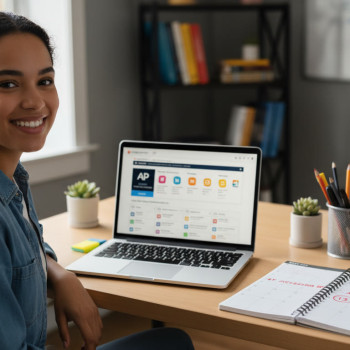Why your practice sessions sometimes feel tougher than the actual Digital SAT
If you’ve ever finished an intense Digital SAT practice test and thought, “There’s no way the real test is that hard,” you’re not alone. Many students feel practice is harsher than the actual exam. That perception can be frustrating, even discouraging—but it’s also useful. Understanding why practice often feels harder clears the fog and gives you a strategic edge going into test day.
Three simple truths behind the feeling
Let’s start with the basics. There are three overlapping reasons practice feels tougher:
- Practice is designed to stretch your limits. Practice pools include a mix of easier, middle, and stretch problems so you build skills beyond your comfort zone.
- Adaptive practice and curated question banks push you on weaknesses. When you practice with question banks or adaptive tools, they intentionally give more items in areas where you’re weaker—so you see a higher concentration of hard items than you might on one real test form.
- Mental context and testing conditions differ. Practice often happens at home, in long sessions, or in a worried state. Those factors amplify difficulty. Conversely, test day has the adrenaline of a single, time-limited event and sometimes feels more straightforward.
Why being pushed harder is actually a good thing
It’s tempting to view difficult practice as an unfair obstacle. A better frame: hard practice equals better preparedness. Here’s why:
- Facing tougher problems builds resilience and reduces surprise on test day.
- Intentionally confronting weak spots means fewer mistakes when it matters.
- Practice that simulates long exposure to challenging items builds stamina—an often-overlooked component of SAT performance.
How the Digital SAT’s format and practice ecosystem create the mismatch
The Digital SAT is delivered through a specific testing platform with certain features and practice pathways. Understanding these can help you interpret why practice feels different from the actual test.
1. Adaptive testing and practice tools
Some practice tools use adaptive question selection or targeted question banks. If a practice module notices you struggle with particular question types, it will deliver more of those. That concentration makes practice sessions feel heavier than a single, balanced test form.
2. Official practice platforms and Bluebook simulations
Official digital practice options include test preview modes and full-length practice tests that aim to mirror the test experience. However, when you combine official practice with additional targeted drills—especially on weaker topics—you create an experience that is intentionally steeper than a standard test form. That’s useful, but it feels harder.
3. Differences in timing and question mix
During practice you might try untimed drills, painstakingly broken apart lessons, or—on the opposite end—timed sections where you focus only on hard items. Real Digital SAT sections are balanced across difficulty and have uniform timing. Practice routines often violate that balance to maximize learning.
The psychology of practice vs. test day
Feelings matter. The mind interprets practice differently than a one-off high-stakes event. Here are psychological dynamics that make practice feel tougher—and what to do about them.
Effort bias: why you notice hard practice more
When you study intensely, you pay attention to the friction. You notice the wrong answers, the frustrating problems, the moments you feel stuck. On test day your brain focuses on completing the task. That difference in focus can create the illusion that the practice was harder.
Motivation and novelty
Practice often includes material you haven’t seen or that’s framed to challenge you. Novelty increases the perceived difficulty. Test day, in contrast, will follow an expected structure and sequence you’ve already rehearsed.
Performance pressure vs. learning pressure
Practice is for learning; the test demands performance. When you’re learning, struggle is productive. But in the moment, struggle feels negative. Reframing practice as productive discomfort helps turn frustration into fuel.
Practical strategies: get the benefits of challenging practice without the discouragement
Here are concrete ways to make tough practice work in your favor—keeping morale high while you make real gains.
1. Use a two-stage practice approach
Separate practice into a controlled “test simulation” and a targeted “skill workout.”
- Simulation: Take a full-length practice test on the Bluebook simulator (timed, under test-like conditions) to mimic test day flow and tools.
- Workout: After scoring your simulation, run targeted packets of hard questions on your weakest topics. These should feel harder—they’re supposed to.
2. Keep a short, focused error log
Record each mistake with 3 quick notes: problem type, why you erred, and one fix. Over time you’ll see patterns instead of isolated failures. That pattern-identifying is transformational.
3. Practice with the test interface before the day
Spend time in the official testing app’s preview and full-length practice to learn the tools: highlighting, the built-in calculator, flagging questions, and navigation. Familiarity reduces friction and turns unfamiliar interface behavior into muscle memory.
4. Simulate test-day conditions intentionally
Do at least two full-length, timed practice tests under test-like settings: same start time of day, minimal interruptions, and realistic breaks. Use the official timer, sit in a quiet space, and use the same device if possible.
5. Mix in short, high-yield drills to protect confidence
Balance heavy workouts with quick wins: 15–25 minute sessions that focus on 10–12 questions you can solve correctly and quickly. That steady success helps keep motivation strong while you tackle harder material elsewhere.
How to interpret scores from hard practice
If practice yields a lower score than you hoped, don’t panic. Use the results diagnostically.
| Situation | Likely cause | Action to take |
|---|---|---|
| Repeated low scores on hard practice | Targeted weaknesses; insufficient skills practice | Break topics into fundamentals; apply 15–20 minute drills daily |
| Good scores on simulations, poor on workouts | Strong test-taking stamina, weaker depth on specific concepts | Allocate weekly deep-dives into problem types you miss |
| Better test-day performance than practice | Practice over-concentrated on extremes; test forms more balanced | Trust simulations; refine timing and guessing strategy |
How to convert hard practice into test-day gains
Build a short plan after each practice test:
- Identify the three most frequent mistake patterns.
- Create one 20–30 minute practice block devoted to fixing those patterns.
- Retest on that pattern in 3–5 days to check progress.
Examples: What “harder practice” looks like—and how to respond
Here are two compact examples that show the path from frustration to improvement.
Example 1: The algebraic trap
Scenario: During a practice workout, you miss several multi-step algebra questions because you make sign errors or skip a step.
- Response: Create a 20-minute “algebra routine” focused on methodical equation-checking (rewrite the equation, isolate variables, substitute back to verify).
- Measure: Track whether the same mistakes reoccur in the next practice test. If not, gradually increase difficulty.
Example 2: Reading passages that overcomplicate
Scenario: Targeted reading sessions give you passages dense with qualifiers and unusual structure; you miss inference questions.
- Response: Practice active annotation (underline topic sentences, mark shifts in tone) and work on paraphrasing paragraphs into 1-line summaries.
- Measure: Time per passage should decrease while accuracy increases—if time falls but accuracy drops, slow down and refine annotation habits.
Study resources and support that make hard practice effective
Hard practice becomes valuable when it’s directed and supported. You’ll get the most growth from a mix of official practice, targeted drills, and personalized guidance.
Official practice and smart tools
Do your full-length simulations on the official practice platform to learn the interface and timing. Then use targeted question banks for skill-building. Alternate between the two intentionally so you get both realism and stretch.
Why personalized tutoring accelerates the benefit of hard practice
Tutors don’t just give answers—they diagnose the root cause of a mistake and show how to fix it reliably. A good tutor will:
- Pinpoint the one misconception behind repeated errors.
- Design short, focused drills you can complete between sessions.
- Teach timing strategies that match your processing speed and strengths.
If you’re using a tutoring service like Sparkl, for example, the combination of 1-on-1 guidance, tailored study plans, expert tutors, and AI-driven insights can help turn challenging practice into consistent score gains—without wasting time on drills that don’t address your specific needs.
Test-day tactics that benefit from hard practice
When practice is tougher than test day, you’ve already trained to handle difficulty. Here are tactics to apply on the actual test.
1. Start steady, build confidence
Begin the test with a calm, methodical pace. If practice included many hard questions early, you’ll feel relief when you encounter a more balanced mix on test day—use that uplift to reinforce focus.
2. Use the flag-and-move strategy
Flag questions that require longer work and move on. Hard practice conditions teach you to conserve mental energy for the items you can win quickly.
3. Trust structured guessing
Because practice often amplifies hard items, you may have practiced strategic guessing more frequently. On test day, use elimination and consistent guessing rules rather than getting stuck seeking a perfect solution.
Building a 6-week plan that uses hard practice wisely
If you have about six weeks to test day, here’s a sample framework that balances simulations, targeted workouts, and confidence-building sessions.
- Week 1: Diagnostic simulation (official Bluebook full-length). Create an error log. Identify top 3 weakness areas.
- Week 2: Skill-focused workouts (3 sessions on weak topics). Short timed drills and one quick-win session every other day.
- Week 3: Simulation under test-like conditions. Review errors and refine timing. Practice interface tools in the app.
- Week 4: Deep-dive into weakest sub-skill. Include at least two 45-minute tutor sessions or guided reviews to change habits.
- Week 5: Balanced practice—mix of targeted workouts and a second simulation. Evaluate progress; adjust strategy.
- Week 6: Light practice, confidence-building, two short timed sections, rest, sleep routine. Final simulation only if needed to tune timing.
Common student questions (answered)
Q: If practice is harder, should I avoid it?
A: No. Hard practice is one of the most efficient ways to improve. Don’t get disheartened—use the results to guide targeted, short, fix-focused study.
Q: How many full-length practice tests should I take?
A: Take at least two full-length, timed simulations: one early for diagnostic purposes and one 1–2 weeks before test day. Add a third if you feel you need more timing practice. Between simulations, do targeted workouts tailored to your errors.
Q: Should I ever practice only easy questions to build confidence?
A: Short confidence sessions are useful, but don’t make them the core of your prep. Alternate confidence drills with the heavier workouts so you progress while protecting morale.
Final thoughts: Reframe discomfort as progress
It’s natural to feel discouraged when practice feels harder than the real test. But that frustration is a sign you’re learning. The key is to channel the discomfort into a strategy: diagnose quickly, practice deliberately, and measure progress in small, objective steps.
Remember: the Digital SAT is a test of skills and stamina more than one-off brilliance. If your practice is intentionally harder, you’re training for the upper range of what you might face. With focused work—especially targeted help like 1-on-1 tutoring, tailored study plans, and AI-driven insights that coach your next steps—you can turn tough practice into a powerful advantage on test day. Services that pair human tutors with smart study plans (for example, Sparkl’s personalized tutoring approach) can be especially helpful because they guide you through the exact transition from painful practice sessions to confident performance.
Trust the process. Train as if the practice is harder than the exam, and you’ll walk into test day ready for whatever comes. When the questions feel manageable, you’ll know you earned it.
Good luck—and remember: deliberate, well-structured practice turns temporary difficulty into lasting improvement.















No Comments
Leave a comment Cancel